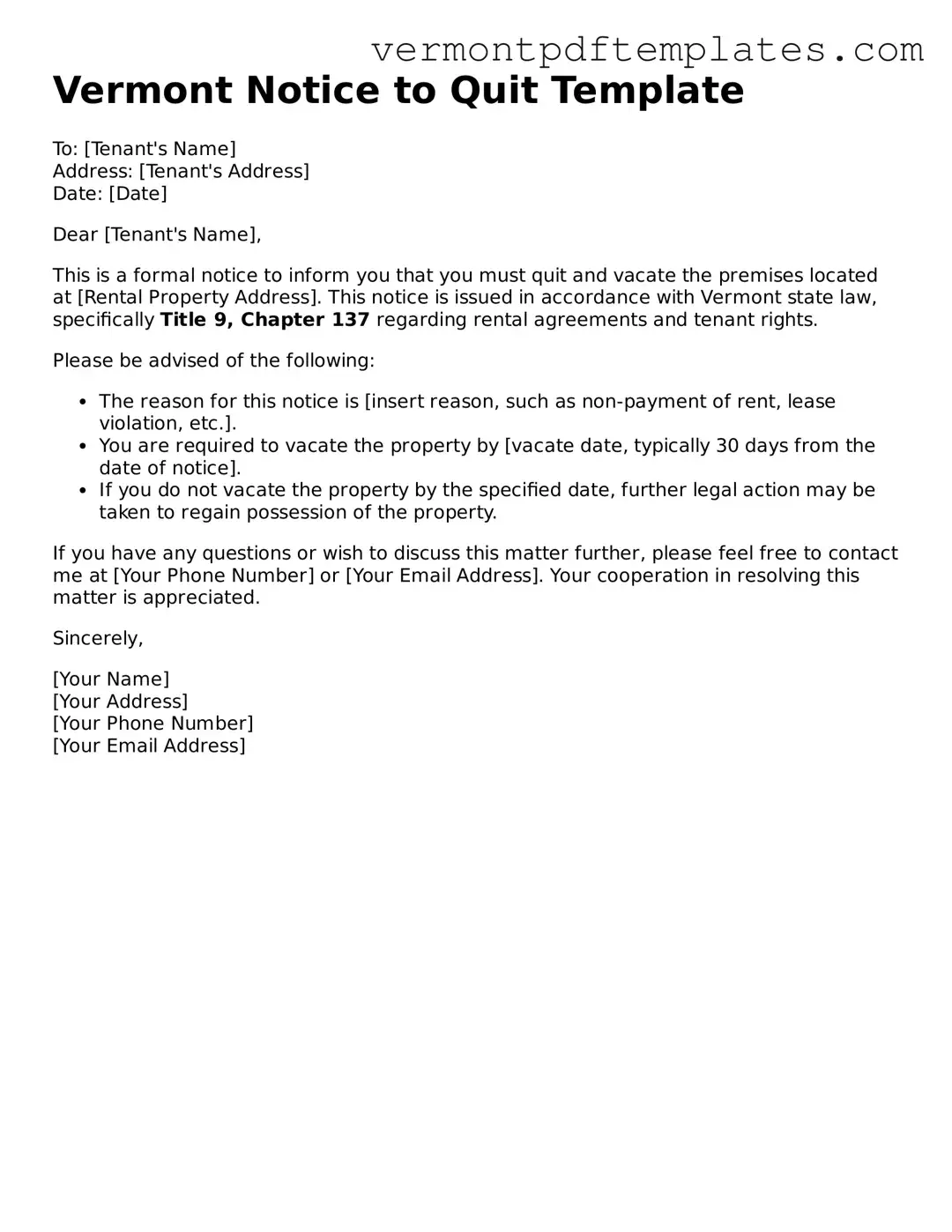The Vermont Notice to Quit form shares similarities with the Eviction Notice, commonly used in many states. Both documents serve as formal notifications to tenants regarding the termination of their lease or rental agreement. The Eviction Notice typically outlines the reasons for eviction, such as non-payment of rent or lease violations, and provides a timeline for the tenant to vacate the premises. Like the Notice to Quit, it emphasizes the need for clear communication between landlords and tenants regarding the expectations and next steps in the eviction process.
Another document akin to the Vermont Notice to Quit is the Lease Termination Letter. This letter is often used by landlords to inform tenants that their lease will not be renewed. Similar to the Notice to Quit, it specifies the date by which the tenant must vacate the property. The Lease Termination Letter is generally more straightforward, focusing on the end of the lease rather than the reasons for termination, but both documents aim to ensure a smooth transition for both parties.
The Notice of Non-Renewal is also comparable to the Vermont Notice to Quit. This notice is issued when a landlord intends not to renew a tenant's lease at the end of its term. Like the Notice to Quit, it must be delivered within a specific timeframe, allowing tenants adequate notice to make arrangements for moving. Both documents aim to clarify the end of the landlord-tenant relationship while providing essential information about timelines and expectations.
Similar to the Notice to Quit is the Demand for Rent. This document is issued when a tenant has failed to pay rent on time. While the primary focus of a Demand for Rent is to request payment, it often serves as a precursor to further actions, such as eviction. Both documents highlight the importance of timely communication and set the stage for potential legal proceedings if issues are not resolved.
The Cure or Quit Notice is another document that resembles the Vermont Notice to Quit. This notice is typically used when a tenant has violated a term of their lease, such as having unauthorized pets or causing damage. The Cure or Quit Notice gives the tenant a chance to rectify the situation within a specified time frame. Like the Notice to Quit, it emphasizes the need for tenants to understand their obligations under the lease agreement.
The Notice of Default is also similar to the Vermont Notice to Quit, particularly in its role in the eviction process. This notice is often issued when a tenant fails to comply with the terms of their lease, such as not paying rent. It serves as a formal warning that legal action may follow if the issue is not resolved. Both documents aim to inform tenants of their rights and responsibilities while outlining the potential consequences of non-compliance.
The Move-Out Notice can be compared to the Vermont Notice to Quit as well. This document is typically used by tenants to formally notify their landlord of their intention to vacate the property. While the Notice to Quit is initiated by the landlord, the Move-Out Notice serves a similar purpose in communicating the end of a tenancy. Both documents help clarify timelines and expectations for both parties involved.
The Termination of Tenancy Notice is another document that aligns with the Vermont Notice to Quit. This notice is often issued by landlords when they decide to terminate a tenancy for various reasons, including lease violations or the landlord's desire to reclaim the property. Like the Notice to Quit, it outlines the necessary steps and timelines for the tenant to vacate, ensuring clear communication throughout the process.
The 30-Day Notice to Vacate is also similar to the Vermont Notice to Quit. This document is commonly used by landlords to inform tenants that they must leave the property within 30 days. Both notices serve to provide tenants with a clear timeframe for moving out, while also ensuring that landlords comply with local regulations regarding notice periods. The focus on timelines and clear communication makes these documents essential in the landlord-tenant relationship.
Understanding the significance of the ADP Pay Stub form is essential for employees seeking clarity on their earnings and tax deductions. This document serves as a pivotal element in verifying income and maintaining transparent employer-employee relationships.
Finally, the Written Notice of Termination shares similarities with the Vermont Notice to Quit. This document is often used by landlords to formally terminate a rental agreement for various reasons. It provides tenants with specific information about the termination and the necessary steps they must take. Both documents emphasize the importance of clarity and communication, ensuring that both landlords and tenants are on the same page regarding the end of the tenancy.
